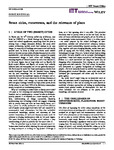Smart cities, metaverses, and the relevance of place
| dc.contributor.author | Aurigi, Alessandro | |
| dc.date.accessioned | 2022-05-06T08:21:59Z | |
| dc.date.available | 2022-05-06T08:21:59Z | |
| dc.date.issued | 2022-05-05 | |
| dc.identifier.issn | 2631-7680 | |
| dc.identifier.issn | 2631-7680 | |
| dc.identifier.uri | http://hdl.handle.net/10026.1/19196 | |
| dc.description.abstract |
A TALE OF TWO (SMART?) CITIES In Yemen sits the 16th Century walled city of Shibam, now listed by UNESCO as a World Heritage site. Beyond its historical and cultural significance, something about the place is striking from a design viewpoint. Shibam, like many other ancient settlements, embeds much local wisdom in its own design. Its unusually tall buildings were constructed with locally sourced mud. Its fabric is dense and creates much needed shade in the city's narrow streets. Studies demonstrate its rather sophisticated—and certainly low‐carbon—approach to passive environmental design at both urban and building level, ensuring degrees of thermal comfort in such a hot climate [1]. In the same region, also sit large cities such as Riyadh, the Saudi capital. Shibam and Riyadh, of course, have radically different sizes and economies and are not generally comparable. But it must be noted that those contemporary centres have mainly developed beyond their old historical towns, hinging not on local knowledge but on ‘international’ criteria— normally dictated by modernist visions of urbanism and architecture. Yet, in the harsh climate of the Arabian Peninsula, it takes much effort—and energy—to sustain cities made of steel‐and‐glass buildings buffered by large public spaces. Saudi Arabia seems to use about 70% of its electricity consumption simply to operate air conditioning systems. Why am I invoking an ancient town to discuss smart cities? The point is that adopting and implementing technologies— however past or contemporary—cannot be seen as deterministically positive. It all depends on a more complex, and holistic, understanding of design approaches. Similarly, implementing new technology should not suggest jettisoning what is already there, and what we have already learnt—in a city, a place—as wholly inadequate and out‐of‐date. Shibam and all similar places might have been ‘old’ and unsuitable to accommodate rapid urbanisation, but they also embedded accumulated knowledge, wisdom and awareness of their context. Innovation, yet with such lessons in mind, could be precious in shaping contemporary cities in the same region. The point therefore is that ‘making smart’ without a deep understanding of place is probably not that smart after all | |
| dc.format.extent | 157-159 | |
| dc.language | en | |
| dc.language.iso | en | |
| dc.publisher | Wiley Open Access | |
| dc.title | Smart cities, metaverses, and the relevance of place | |
| dc.type | journal-article | |
| dc.type | Editorial | |
| dc.type | Journal | |
| plymouth.issue | 3 | |
| plymouth.volume | 4 | |
| plymouth.publication-status | Published | |
| plymouth.journal | IET Smart Cities | |
| dc.identifier.doi | 10.1049/smc2.12030 | |
| plymouth.organisational-group | /Plymouth | |
| plymouth.organisational-group | /Plymouth/Faculty of Arts, Humanities and Business | |
| plymouth.organisational-group | /Plymouth/Faculty of Arts, Humanities and Business/School of Art, Design and Architecture | |
| plymouth.organisational-group | /Plymouth/REF 2021 Researchers by UoA | |
| plymouth.organisational-group | /Plymouth/REF 2021 Researchers by UoA/UoA13 Architecture, Built Environment and Planning | |
| plymouth.organisational-group | /Plymouth/Users by role | |
| plymouth.organisational-group | /Plymouth/Users by role/Academics | |
| dcterms.dateAccepted | 2022-04-27 | |
| dc.rights.embargodate | 2022-5-17 | |
| dc.identifier.eissn | 2631-7680 | |
| dc.rights.embargoperiod | Not known | |
| rioxxterms.versionofrecord | 10.1049/smc2.12030 | |
| rioxxterms.licenseref.uri | http://www.rioxx.net/licenses/all-rights-reserved | |
| rioxxterms.type | Journal Article/Review |


